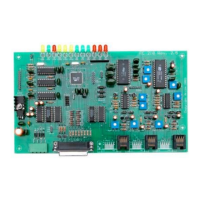23
For example, we want to program Macro 1 so it will turn on CTCSS Access on Port 1, connect Port 1 to Port 2 and change Port 2's
courtesy tone to #4. By looking up these functions on the Macro Function Number chart, we see the function commands we want are
002, 019 and 059. We enter - all in one transmission:
*4002 01 002 019 059
The controller responds with "M A C R O" and the number of the macro we just programmed.
We can even program macros to include other macros. For example, we want to create a macro that in addition to doing what Macro 1
already does, we also want it to change Port 1's courtesy tone to #9. Instead of having to repeat the commands previously stored in
Macro 1, we can simply create a new macro containing the additional function and include Macro 1 as well:
*4002 02 054 401
Macros may be embedded into other macros any number of times, up to the limit that macro can hold.
Using Command Macros To Remap Controller Functions
Another use for Command Macros is to allow user access to controller functions without having to first unlock a port. This gives you
complete control over whom should have access to which functions in the RC-210.
Let's say you want your users to be able to read the RC-210's real time clock easily and you want them to enter "1111" with their radios
in order to do so. First, we program a Command Macro for that function. In this example, we'll use one of the Short Macros - Macro 41 -
since we only need it perform a single function:
*4002 41 116
We can now assign Macro 41 the code of "1 1 1 1".
*2050 41 1111
Now when someone enters "1 1 1 1", the RC-210 will speak the current time (provided you've set the clock that is!). It's that simple.
You can use any of the 90 Command Macros for remapping commands as needed.
Command Macro Priority
Command Macros have 3 different levels of priorities - low, medium and high.
• High - Once a Command Macro starts, nothing will stop it
• Medium - If a Command Macro contains any speech functions, that speech will be controlled by the Speech Override and
Speech ID Override settings. This is the default priority level of all Command Macros.
• Low - Any COS activity on the last active Port will stop that Command Macro and exit.
Priorities are particularly useful for controlling Command Macros that contain speech. For example, you recorded a DVR track with
an informational message, such as "This Repeater Requires a Tone Frequency of 100 Hertz", which plays immediately following
an ID. Some users might take great delight in kerchunking in the middle of the informational message, stopping it because you
have Speech Override turned on. By assigning this Macro a high priority, it will always play uninterrupted.
You assign a Command Macro a priority level by including one of the following function numbers within that macro, as the first one
entered.
228 High Priority
229 Low Priority
Example: Command Macro 12 will play DVR Track 1 and then play an ID on Port 1, as High Priority:
*4002 12 228 162 126 181
After a Command Macro runs, its priority level is automatically reset to Medium.

